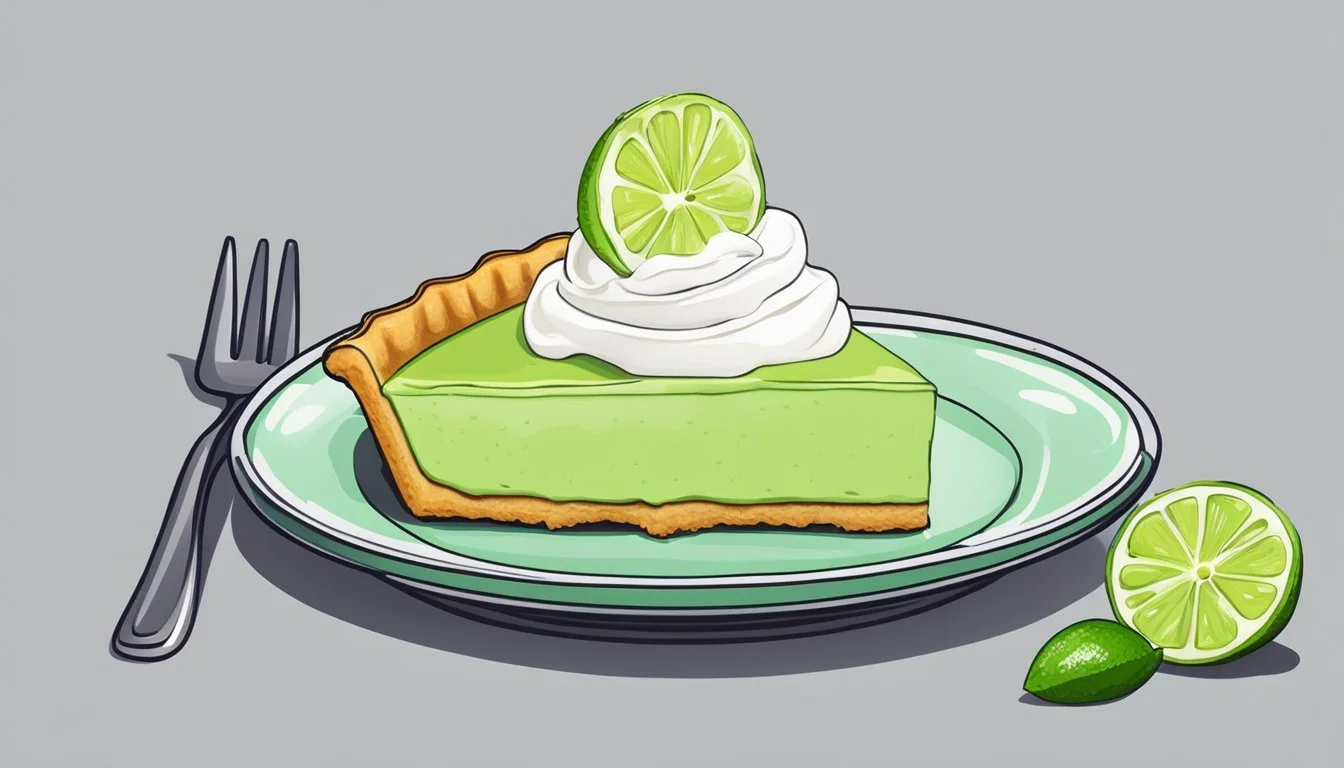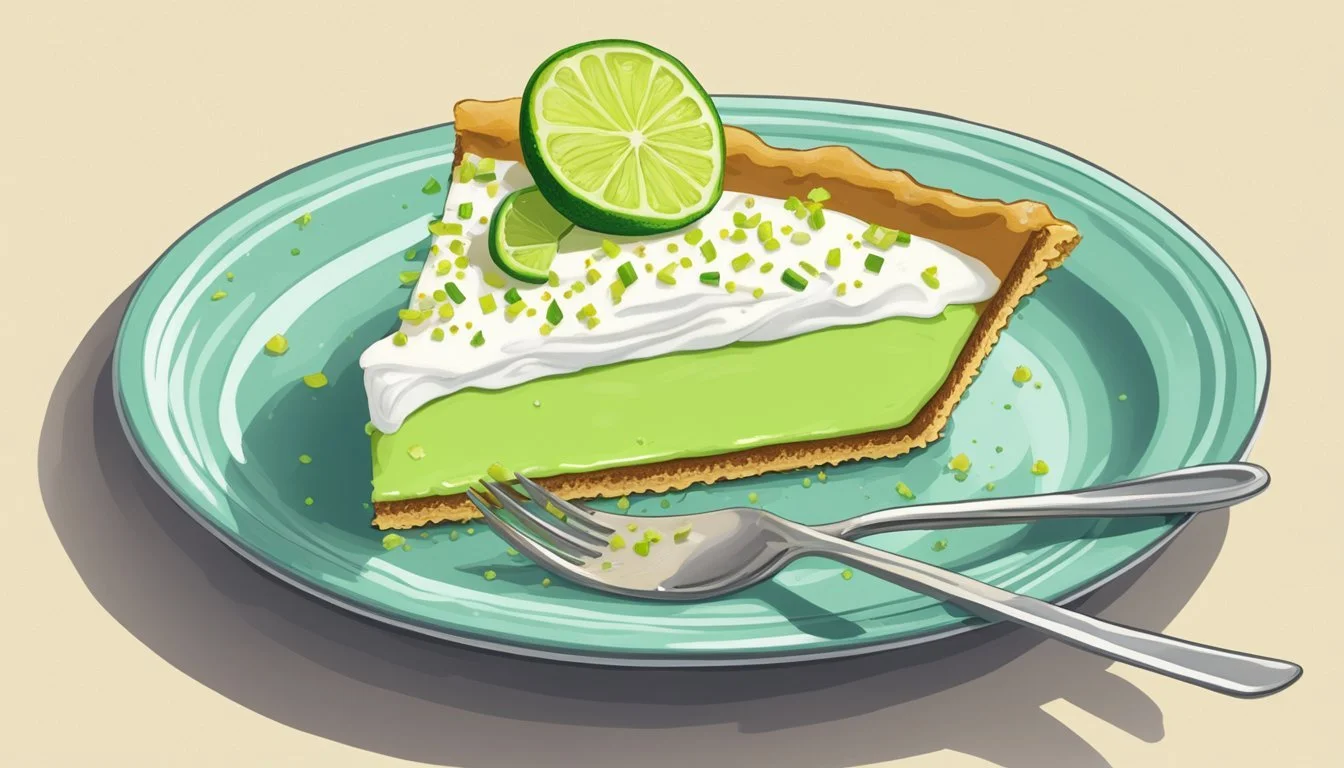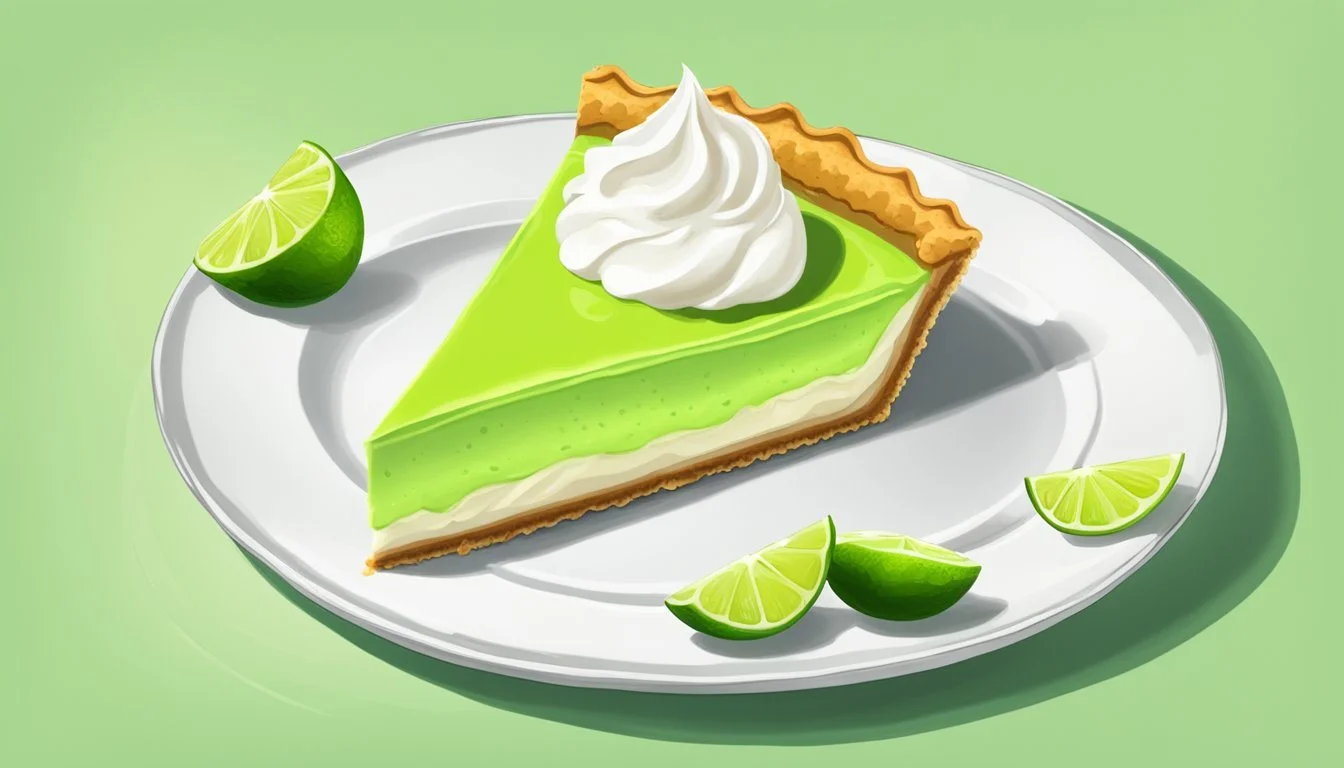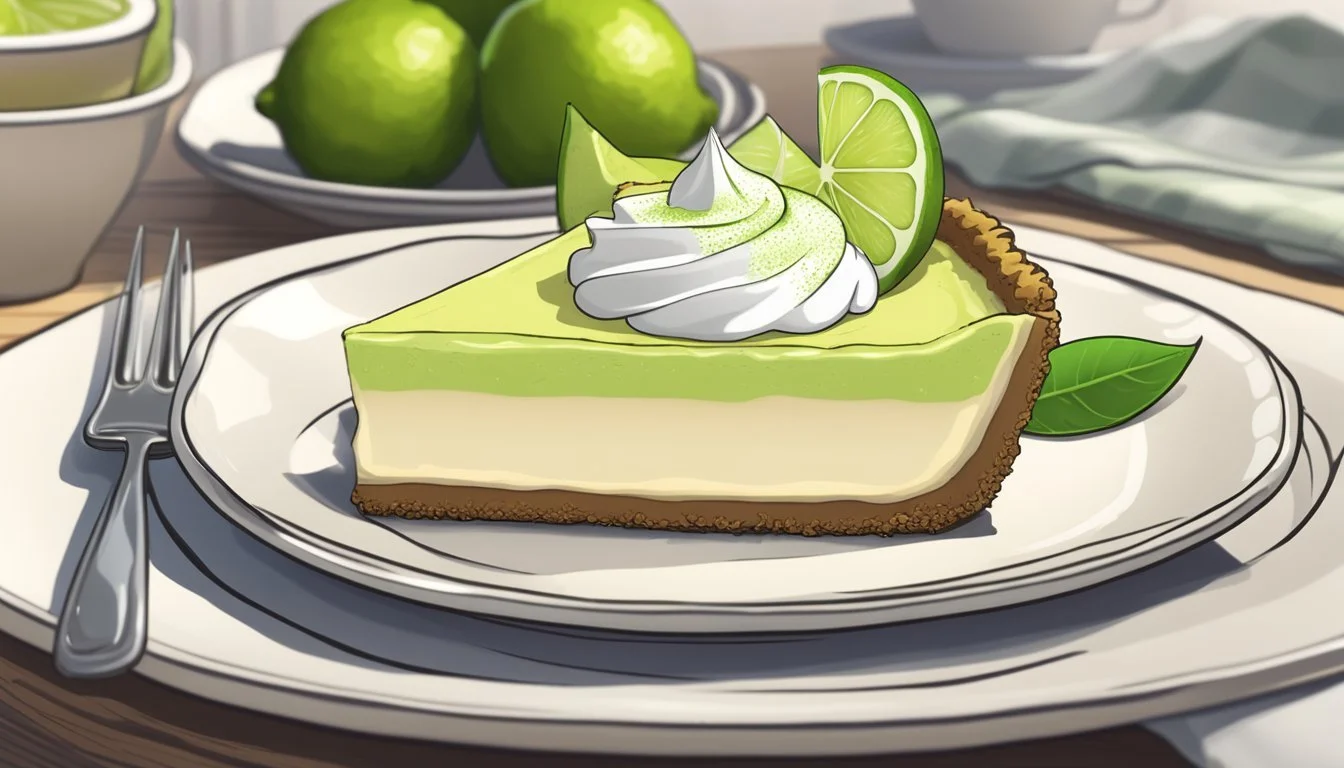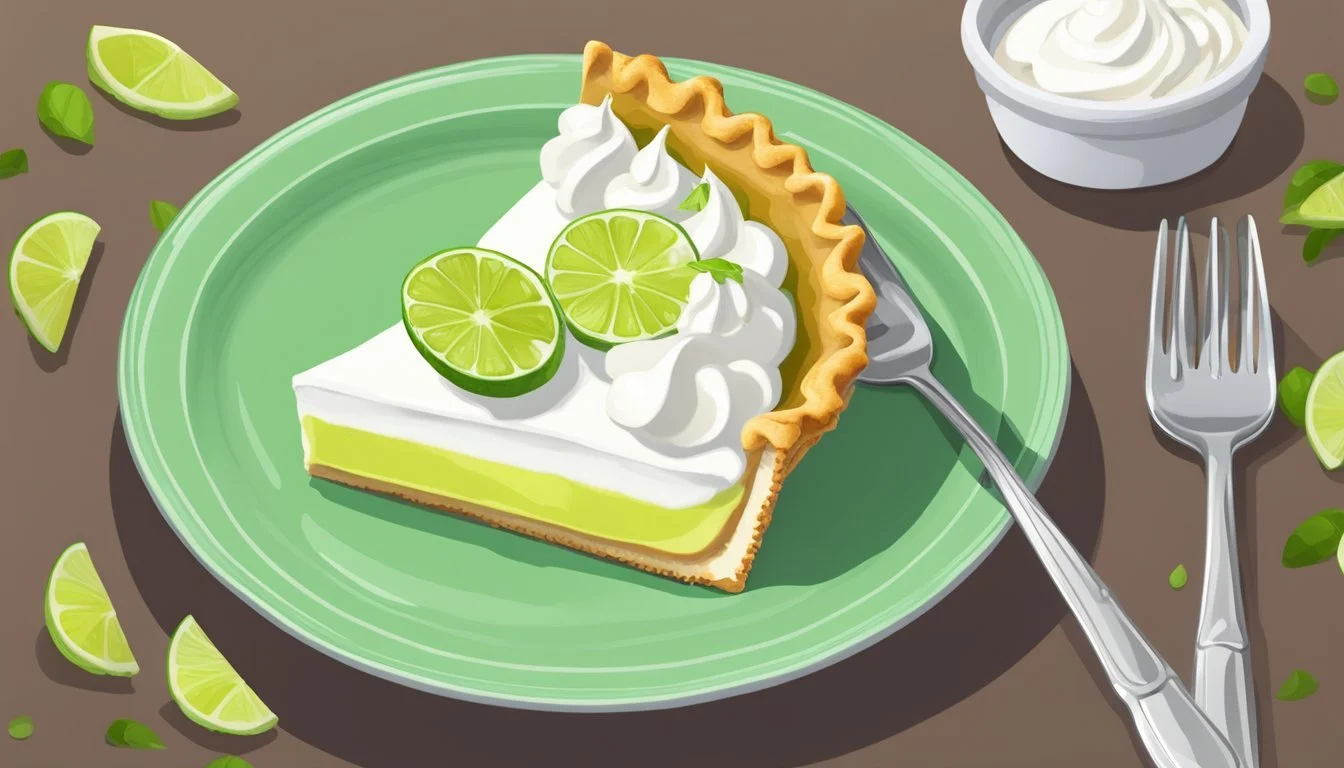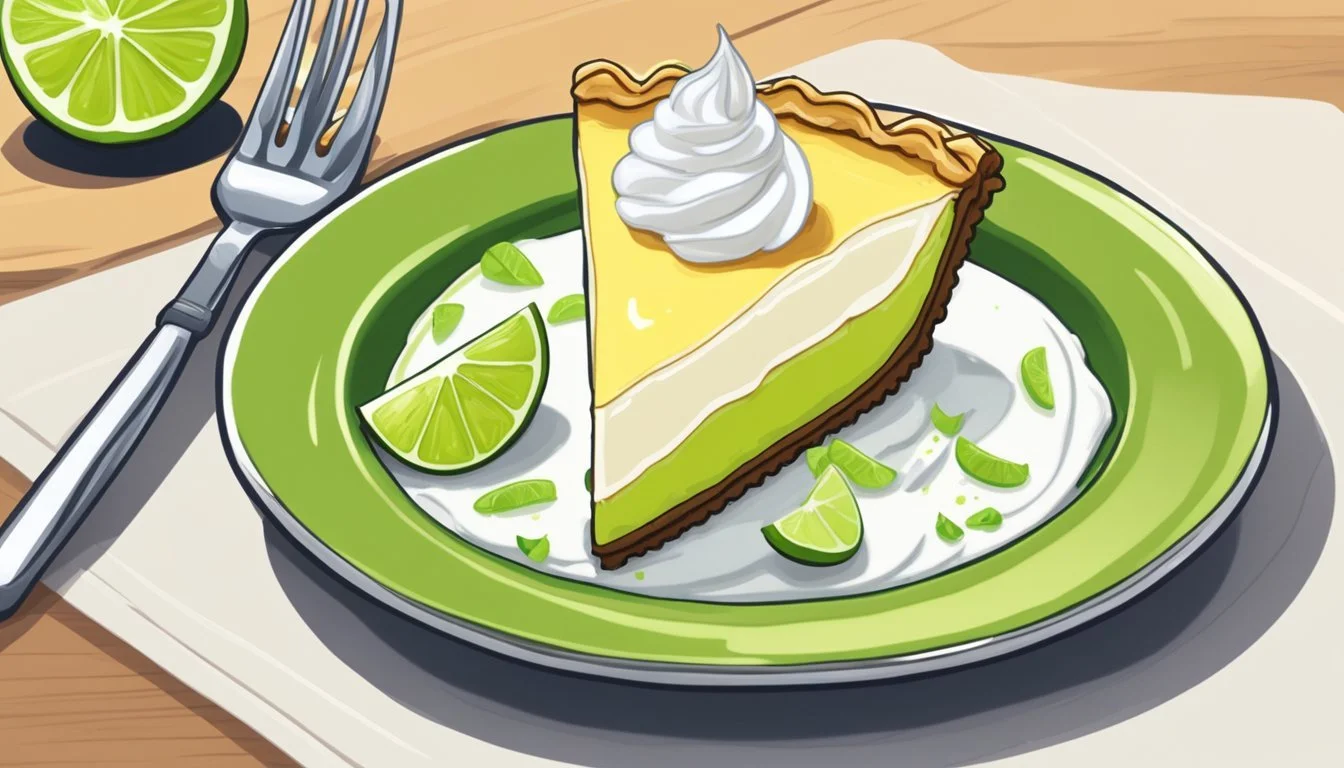How Do You Eat Key Lime Pie?
Simple Steps for the Perfect Bite
Key lime pie is a classic American dessert that originated in the Florida Keys. This tangy treat is known for its smooth, citrusy filling and delightful contrast with a crumbly graham cracker crust. While it's often associated with the sunshine state, its popularity has spread far and wide. The pie's simplicity allows the natural flavor of the key limes to shine through, which is the core attribute of an authentic key lime pie.
When it comes to enjoying this dessert (What wine goes well with desserts?), it is typically served chilled and can be topped with a dollop of whipped cream (how long does cream last?) or a light meringue to complement the sharp flavor of the lime. The balance of sweet and tart makes key lime pie a refreshing end to any meal, especially during warm weather. Despite its unique taste, the pie's preparation is relatively straightforward, involving a baked crust filled with a mixture of key lime juice, egg yolks, and sweetened condensed milk.
The cultural significance of key lime pie in Florida cannot be overstated. It has been designated the official state pie, and in the Florida Keys, where key limes are abundant, claiming to have the best key lime pie is a point of pride. People from all corners come to sample the local variation of this beloved dessert, and many bakeries and restaurants hold their recipes close to the heart, each adding a personal touch that reflects their interpretation of the perfect key lime pie.
History and Origin
The key lime pie, renown for its rich flavor, is tied closely to its birthplace in Florida and the limes that give it its distinctive taste.
Origins of Key Lime Pie
Key lime pie traces its roots back to the late 19th century in Key West, Florida. There's a commonly told tale of "Aunt Sally," a cook for a Florida ship salvager, who is often credited with creating the first key lime pie in the 1890s. The pie's original recipe called for Key limes, native to Southeast Asia and introduced to the Florida Keys by Spanish explorers. They became a staple in the pie's creation due to their availability and unique tart flavor, distinguishable from the more common Persian limes.
Key Lime Pie in Floridian Culture
Key lime pie is not just a dessert; it's an emblem of Floridian culture. After the 1926 hurricane, Key lime trees were largely replaced with the Persian lime, though the dessert continued to be known as key lime pie. Over time, this pie has become synonymous with Florida's identity, and despite the shift in the type of lime used, the treat remains a cherished tradition within the Florida Keys and beyond, often evoking the sun-soaked and breezy atmosphere of its place of origin.
Key Ingredients
Key lime pie is defined by a unique combination of ingredients that create its signature tart flavor and creamy texture. Each component plays an essential role in the overall taste and structural integrity of the pie.
Understanding the Role of Lime Juice
The star of key lime pie is undoubtedly the lime juice, which imparts the characteristic tangy flavor. Key lime juice is preferred for its floral aroma and slightly tart edge, differentiating it from the juice of regular Persian limes. It is crucial to use fresh lime juice for the best flavor rather than bottled juice.
The Importance of Eggs in Custard
Egg yolks serve a dual purpose: they thicken the filling to create the custard-like texture and contribute to the richness of the pie. The yolks coagulate at baking temperatures, setting the mixture into a smooth and firm filling once cooled.
Choosing the Right Dairy
Dairy adds creaminess to key lime pie. Sweetened condensed milk is traditional, bringing sweetness and dense texture. Some recipes might call for milk or heavy cream as well, which adjusts the pie's richness and creaminess.
Sweeteners for the Perfect Balance
The pie's sweetness counters its tartness, and here, sugar in the crust and sweetened condensed milk in the filling are prevalent. They balance the sharp notes of the lime juice without overpowering the pie's intended flavor profile.
Preparing the Crust
The crust of a key lime pie sets the foundation for its delectable filling. Achieving a firm yet crumbly texture requires precision and care, often beginning with graham cracker crumbs and butter as the primary ingredients.
Graham Cracker Crust Basics
The classic key lime pie crust starts with graham cracker crumbs. To prepare, one must mix the crumbs with melted butter in a mixing bowl until well combined. The proportions are crucial—the typical ratio is about 1 and 1/2 cups of crumbs to 1/3 cup of melted butter. This mixture is then pressed into the bottom and up the sides of the pie pan to form the crust.
Steps to Prepare Graham Cracker Crust:
Combine graham cracker crumbs with melted butter.
Press the mixture evenly into the pie pan.
Bake at 350°F (180°C) for 10 minutes.
Allow the crust to cool before adding the filling.
Alternatives to Graham Crackers
Should you wish to stray from tradition or accommodate dietary restrictions, various alternatives can replace graham crackers. Options like digestive biscuits, vanilla wafers, or even cookie crumbs offer a different flavor profile and texture. Gluten-free substitutes are also available for those with sensitivities.
Alternative Crust Options:
Digestive biscuits
Vanilla wafers
Gluten-free cookies
Achieving the Perfect Texture
A well-made graham cracker crust is one that is firm enough to hold its shape but crumbly enough to complement the creamy filling. This balance is achieved by firmly pressing the crust mixture into the pan and baking it briefly to set. It's important that the crust is not overly compacted or it may become hard after baking.
Tips for Perfect Texture:
Firmness: Use the bottom of a glass to press the crust mixture evenly.
Thickness: Aim for a crust thickness of about 1/4 inch.
Baking: Bake just until the crust is slightly browned.
It is essential that, throughout each step, the blend of crumbly texture and structural integrity is maintained to ensure the crust can support the rich lime filling of the pie.
Making the Filling
The filling of a key lime pie is a creamy, custard-like mixture that takes center stage in this classic dessert. The process involves combining key ingredients, achieving the right consistency, and then baking to perfection.
Combining Key Ingredients
When creating the filling for a key lime pie, one begins by mixing the fundamental components. These typically include:
Key lime juice: The star ingredient that gives the pie its distinctive tangy flavor.
Egg yolks: Helps in thickening the filling and contributes to its smooth texture.
Sweetened condensed milk: Adds sweetness and creamy consistency.
These ingredients should be combined in a large mixing bowl. To blend them effectively, one should use a whisk, which will ensure a uniform mixture without overbeating.
Achieving the Right Consistency
The proper consistency of key lime pie filling is thick yet pourable, akin to a well-made custard. This texture is achieved by whisking the egg yolks and sweetened condensed milk until they are well incorporated. The key lime juice is then added gradually to maintain control over the consistency. One should continue to whisk the mixture until all ingredients are thoroughly combined and no streaks of egg are visible.
Baking and Setting the Filling
Once the filling mixture is ready, it is poured into the pre-baked crust. Baking is a critical step where the filling turns from a liquid state into a set, yet slightly wiggly custard at the center. This transformation occurs in an oven typically preheated to a temperature ranging from 325°F to 350°F (163°C to 177°C). The baking duration varies, but it usually takes between 10 to 17 minutes for the custard to set appropriately.
After baking, the pie should gradually cool to room temperature on a wire rack before being refrigerated. It is essential to chill the pie thoroughly, for a minimum of 3 hours or, optimally, overnight, to ensure that the filling is properly set and achieves the ideal texture.
Pie Toppings
Selecting the right topping for key lime pie can enhance its flavor and presentation. Whether one prefers the creamy richness of traditional whipped cream or the light, airy texture of meringue, thoughtful garnishes can add a delightful contrast.
Traditional Whipped Cream
Whipped cream is the quintessential topping for key lime pie, offering a sweet and creamy counterbalance to the tartness of the lime filling. One can either use homemade whipped cream, which typically consists of heavy cream and powdered sugar whipped to soft peaks, or opt for store-bought varieties if convenience is a priority.
Meringue: A Lighter Alternative
For those looking for a lighter topping, meringue can be an excellent choice. Meringue topping is made by whisking egg whites and sugar until they form stiff peaks and then lightly baking it to set. This results in a fluffy texture with a slight crispiness that complements the dense pie beneath.
Creative Garnishes for Key Lime Pie
Dressing up key lime pie with garnishes not only adds visual appeal but also can introduce new textures and flavors. A sprinkle of lime zest can intensify the pie’s citrus notes, while thin slices of lime provide a hint of elegance. For an extra touch of sweetness, a light dusting of powdered sugar might be used just before serving.
Baking Instructions
Making a Key Lime Pie requires precise baking techniques and attention to detail in terms of temperature, timing, and cooling methods. Here's how to perfect the art of baking this classic dessert.
Temperature and Timing
For the ideal bake, preheat your oven to 325°F (163°C). During baking, the crust, typically a mixture of graham cracker crumbs and butter, should be placed in the oven first. It's baked for about 10 to 15 minutes or until it starts to darken slightly. Once the crust is removed and cooled, the filling, which consists mainly of lime juice, egg yolks, and sweetened condensed milk, is poured in. The filled pie then returns to the oven, baking until the center is set but still slightly wiggly—a process that generally takes 15 to 17 minutes.
Cooling and Serving Key Lime Pie
After baking, transfer the pie to a wire rack to allow it to cool down to room temperature; this usually takes at least an hour. To ensure the filling sets perfectly, refrigerate the pie for a substantial amount of time before serving—typically around three to four hours. Before slicing, one might want to gently run a knife around the edge of the pie to separate the crust from the pan for easier serving. Refrigeration not only helps to firm up the pie for clean slices but also enhances its flavor.
Serving and Storage
When enjoying key lime pie, its presentation and storage are essential elements that affect both taste and longevity. Proper refrigeration ensures flavors are maintained, while the method of serving enhances its appeal.
Presentation Tips
One must present key lime pie in a manner that highlights its rich texture and vibrant color. Serve slices on individual plates, with an optional dollop of whipped cream on top. The pie should be chilled and removed from the refrigerator just before serving to maintain its consistency and flavor. Use a clean, sharp knife dipped in warm water to make smooth cuts and wipe the blade between slices.
Storing for Freshness
To keep leftovers fresh, store the key lime pie in a refrigerator at a temperature between 36°F (2°C) to 40°F (4°C). Wrap the pie or individual slices tightly with plastic wrap or aluminum foil to protect from other food odors and to prevent moisture loss. Enjoy refrigerated key lime pie within 2-3 days for the best tasting experience.
Freezing and Thawing Instructions
For longer storage, freezing key lime pie is a viable option. To freeze, wrap the pie securely with both plastic wrap and aluminum foil. Store in the freezer, where it can last for 2-3 months. To thaw, transfer the pie to the refrigerator and allow it to gradually defrost overnight. One should serve a previously frozen pie chilled to ensure optimal taste and texture.
Variations of Key Lime Pie
Key lime pie is celebrated for its creamy texture and tangy flavor, but creative twists can transform this classic dessert into various innovative forms, each offering a unique experience of the beloved treat.
Key Lime Pie Bars
For those who prefer a handheld dessert option, Key Lime Pie Bars transfer the classic pie format into a more casual, yet equally delicious snack. The crust is pressed into a baking pan and topped with the traditional custard filling. Once cooled, they're cut into bar-sized portions that offer a balance of crunchy crust and creamy center, making them an excellent choice for picnics or potlucks.
Incorporating Unique Flavors
Chefs often enjoy infusing unique flavors into key lime pie for a refreshing twist. Strawberry and banana are popular additions, resulting in hybrids such as Fresh Strawberry Key Lime Pie or Banana Cream Key Lime Pie. These variations not only add distinct flavors but also enhance the pie with layers of texture, such as the softness of banana or the juiciness of ripe strawberries.
Dietary Adaptations
Tailoring key lime pie to various dietary restrictions has led to the creation of Dietary Adaptations. Gluten-free graham crackers can be used to accommodate those with gluten sensitivities. To cater to those following a vegan diet, dairy ingredients are substitutable with plant-based alternatives like coconut milk or soy-based cream cheese, maintaining the pie's iconic creamy consistency without the use of animal products.
Nutritional Information
Key lime pie is a popular dessert that carries a distinct nutritional profile. The dessert's calorie content varies depending on its size and specific recipe, but a standard piece (1/8 of a 9" diameter pie) generally contains around 364 calories. When it comes to macronutrients distribution, it typically has:
Fat: 40%
Carbohydrates: 54%
Protein: 6%
Calorie Breakdown by Serving Size:
1 oz: 81 calories
100 g: 287 calories
1 piece (1/8 of 9" pie): 364 calories
The pie's considerable sugar content is largely due to the use of sweetened condensed milk, which is a key ingredient in many recipes. It not only provides the creamy texture but also adds to the overall sweetness of the dessert.
Fat Content: The fat in key lime pie partly comes from the butter in the crust and the evaporated milk or sweetened condensed milk used in the filling. While some recipes use one or the other, evaporated milk tends to be less rich in fat compared to sweetened condensed milk.
Detailed Fat Content:
Total Fat: 22g (28% DV)
Saturated Fat: 11g (55% DV)
Polyunsaturated Fat: 1.3g
Monounsaturated Fat: 8.9g
Cholesterol levels can also be significant, for instance, around 146mg (49% DV) per serving, largely attributable to the dairy components and egg yolks typically found in the pie filling.
It's notable that one pie can vary greatly from another based on the exact ingredients and proportions used, so for those mindful of their nutritional intake, they should seek specific nutritional information for the pie they're consuming.
Health and Safety Considerations
When enjoying key lime pie, it's crucial to consider food safety, particularly concerning raw eggs and allergens. Below are health and safety practices to ensure a safe and enjoyable experience.
Use of Raw Eggs
In many key lime pie recipes, raw eggs are used to create the creamy filling. While the acid in lime juice can mitigate some bacteria, it's not always sufficient to ensure food safety. The use of pasteurized egg whites can reduce the risk of salmonella, especially when the pie is not baked after adding the eggs. To ensure safety, consumers should either cook the pie filling adequately or opt for recipes that avoid raw eggs altogether.
Suitable Substitutes for Allergies
Key lime pie often contains allergens like nuts (in crusts) and dairy. For those with allergies, substitutes can be used. Almond flour can be replaced with a gluten-free alternative for a nut-free crust. Dairy components like condensed milk or whipped cream can be swapped for coconut milk or lactose-free options. It's vital to clearly label any known allergens when sharing or serving key lime pie to others.
Tips and Tricks
When enjoying key lime pie, the emphasis is on the balance of flavor, texture, and presentation. These tips and tricks are designed to perfect each slice of pie, from enhancing its tart key lime essence to achieving a desirable consistency and aesthetic appeal.
Enhancing Flavor
Key lime zest is a crucial ingredient for intensifying the pie's flavor. For the best results, one should zest the lime directly into the mix to ensure the oils contribute to the tart character of the pie. A dash of lemon juice can be added to brighten the flavor if key limes aren't available.
Use fresh key lime juice: Preferably squeezed from key limes for optimal tartness.
Add lemon juice: To complement the tartness when key limes are scarce.
Achieving the Perfect Pie Texture
The texture of key lime pie should be creamy and smooth. To achieve this, one must carefully combine heavy whipping cream with the other filling ingredients until seamlessly smooth.
Heavy whipping cream: Whisk until it forms soft peaks for a luxurious texture.
Cream cheese: (how long does cream cheese last?) Incorporate well to add richness and stability to the filling.
Decorating Like a Pro
A key lime pie’s appearance should not be overshadowed by its taste. Garnishes and decorations are vital for a professional finish. One can dust the pie with powdered sugar, confectioners' sugar, or use piped whipped cream to introduce an element of elegance.
Garnish options: Lime slices or zest, and a sprinkle of powdered sugar enhance the visual appeal.
Whipped cream: Stabilized with vanilla extract and confectioners' sugar for piping designs.
FAQs & Common Mistakes
In this section, readers will find answers to some of the most popular questions about consuming Key lime pie, as well as guidance on how to sidestep common baking errors that can impact the quality of this classic dessert.
Answering Popular Questions
Can regular limes be used instead of Key limes? One can use regular limes in a pinch, but they should be aware that Key limes are more aromatic and have a tarter, more floral flavor that characterizes the classic Key lime pie.
Is there a special way to eat Key lime pie? Key lime pie is typically served cold and often garnished with a dollop of whipped cream or a slice of lime to complement the tartness of the pie.
Avoiding Common Baking Errors
Mistake: Using bottled lime juice. Bottled juice can result in a less flavorful pie; fresh Key lime juice is preferred for its potent zest and freshness.
Mistake: Overbaking the pie. The filling should be baked until set but still jiggly. Overbaking can cause the filling to separate or create a less creamy texture.
Mistake: Forgetting a pinch of salt. A pinch of salt can enhance the pie's flavors and instigate the necessary chemical reaction in the crust for better texture.
Mistake: Not cooling the crust. The graham cracker crust should be allowed to cool before adding the filling to prevent it from becoming soggy.
Conclusion
Key lime pie, a family favorite, is best enjoyed cold, offering a refreshing and tangy taste that is a hallmark of its key lime flavor. To fully appreciate its unique citrus character, one should allow the pie to chill thoroughly before serving. The quintessential texture is achieved through careful preparation and adherence to recipe specifics, such as setting the correct internal temperature between 160°F–165°F.
Serving suggestions often include a dollop of whipped cream or a garnish of lime zest, which not only enhances the visual appeal but also complements the tartness of the lime. Those seeking to preserve the pie’s authentic taste should focus on the quality of the limes and opt for fresh key limes over substitutes.
Presentation plays a role in the experience. A slice of key lime pie can be artfully plated to heighten the dining pleasure. It should be served on a clean, simple dish that does not distract from the pie’s vibrant flavor profile.
For storage, key lime pie should be kept in the refrigerator, covered to maintain its freshness. This will ensure that each bite delivers the crisp, tangy sensation that key lime pie aficionados cherish. Whether as a conclusion to a meal or a standalone treat, this dessert remains a refreshing indulgence for all occasions.


